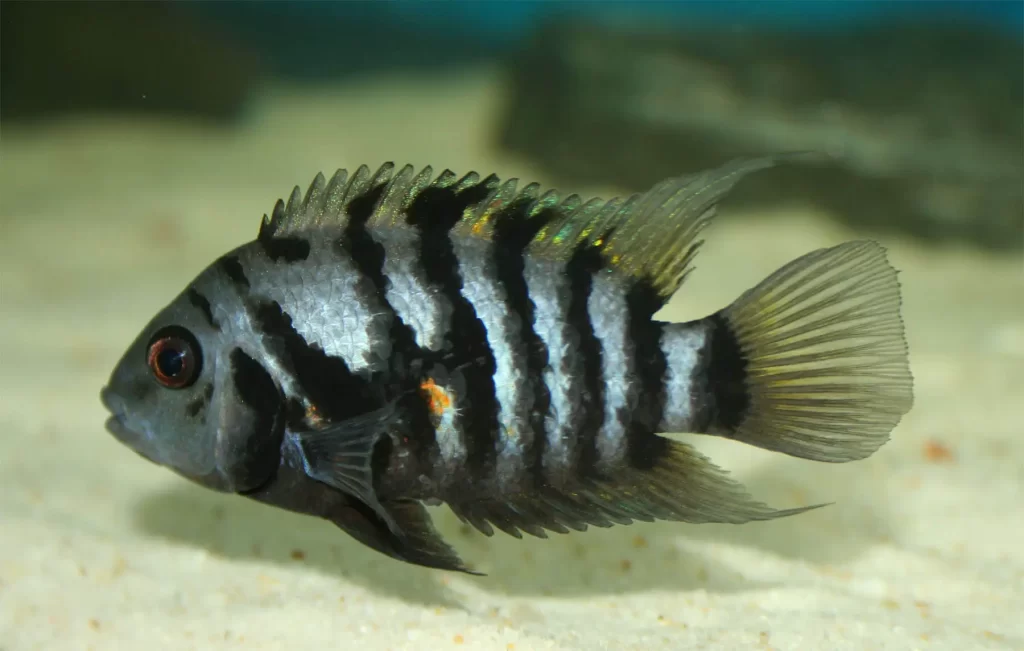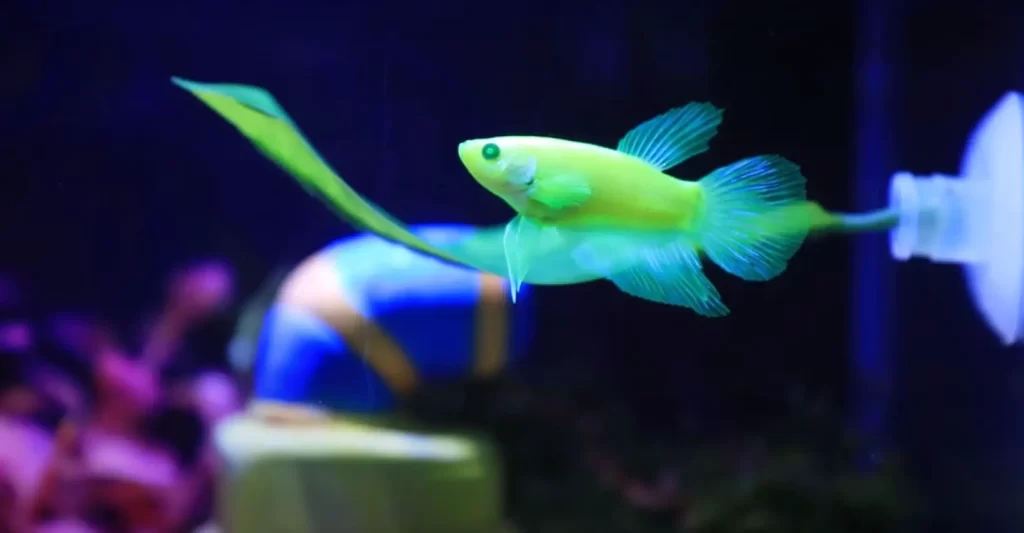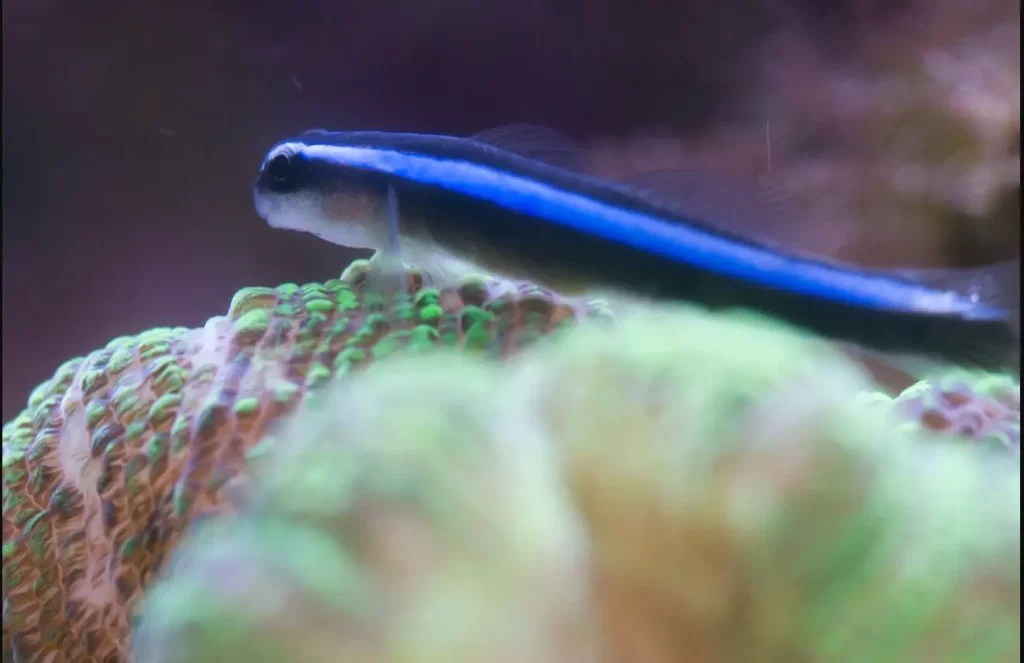Rope fish is a unique looking freshwater fish that many of you may not have seen. On seeing them for the first time, you may confuse them for a snake or an eel. Their bright green color makes them attractive, and you won’t be able to stop yourself from buying one. These fish are not for beginners, but a slight experience in fishkeeping can be of great use. Before keeping any kind of fish, it is essential to know everything about them. That is the main reason behind this article.
In this article, we will be talking all about this fish, including appearance, social behavior, breeding, diet, etc. After reading this, you will surely be able to know a lot about rope fish and be fully prepared for keeping one.
Introduction To Rope Fish
The reed fish(reed-fish), rope fish(rope-fish), or the snake fish gets the name from its rope or snake-like body. Scientifically known as Erpetoichthys calabaricus, it is a freshwater fish of the bichir family. It is a popular choice among fish-keeper these days who have been keeping fish for a long time and want to try something new.
Although they do not come in a wide variety of colors, these fish add a certain charm to your tank with their exciting nature and behavior.
Since these fish can grow up to 15 inches, you may think they are hard to keep. But this is not true because any fish-keeper with a few years of fishkeeping experience can easily keep this fish.
Origin And Habit In The Wild
The fish originates from Benin, Cameroon, Nigeria, and the Republic of Congo. Their natural habit is a vast water system ranging from the Ogun River in Nigeria to the Chiloango River in central Africa.
Their natural habitat consists of slow-moving or standing freshwater or brackish water system. These fish typically inhabit warm water of about 72-82 F. The natural habitat may also have less dissolved oxygen content. This is because the fish has adapted to gulp fresh air from the water surface. To resemble their natural habitat, you must have plenty of plants and caves in your aquarium.
Rope Fish Appearance
It is not hard to imagine getting their name from their snake, rope, and reed-like body structure. Their distinct look surely adds a different exotic charm to your tank.
Their long cylindrical body can length up to 15 inches, so you should have a quite large tank if you are planning to keep them. This flat head, long eel-like body, and thick bony diamond-shaped scales all over the body make this fish something that you want to go for. The brown/green colored scales all over their body can help them adjust in dark areas also.
The fins are either too small or nearly absent in these fish. But this doesn’t create a problem because their slim elongated body can easily help them swim and crawl on land like snakes. It is fair to say that their whole body is a big, long caudal fin because it helps them change direction and glide. The only actual fins that can be visible most of the time are pectoral fins as they have a back spot at the base. The dorsal fins contain almost 15 rays but are hard to distinguish because these fins run along the body.
These fish have a pair of lings to survive in water with a low concentration of dissolved oxygen. This property also allows them to survive for some time in the land. While in water, rope fish gulps the surface air.
Male vs. Female
The male and female can be tough to distinguish. But experts and keepers say that males have more rays on their dorsal fins than the female. But this property is not enough because it is too hard to count and even the rays at the dorsal fins.
Availability
The habitat of rope fish is slowly degrading. The main reason is palm oil plantation, other agriculture, deforestation, industrialization, and urbanization on their native habitat. In western Africa, drainage for agricultural and urban developments has a huge impact on their natural habitat. IUCN has currently classified rope fish as nearly threatened (NT) species.
Lifespan
It may be hard to believe, but a rope fish can survive in a perfectly healthy tank for about 15-20 years. This lifespan is not normal for any aquarium fish, and you must be a dedicated fish-keeper to care for a single fish for such a long time. So, we can say that keeping this fish will test your patience and ability.
Price
You can get young juveniles for nearly $10 in any fish store. The adults may be a little costly, with one costing up to $20. But considering their conservation status, nature, and beauty, it is a fair price to pay.
General Behavior And Tankmates
Rope fish are generally active at night because, in the wild, they are predators. They sneak out in caves and ark areas to hunt their prey. But in the tank, if you feed them at the day, they will adapt to this and become more active in the daytime.
These fish spend most of their time at the bottom of the tank and may sometime even dig holes in the sand. They occasionally come at the surface to breathe. This happens explicitly in an ecosystem where the oxygen dissolved ratio is very less.
These fish are calm by nature and do not attack their tankmates. But rope fish might confuse a small tankmate for food and eat them. So, it is better to avoid fish like tetras, harlequin rasboras, and danios. Usually, these fish don’t eat other fish in the wild, but when something fits in their mouth, they will go for it. You should also avoid invertebrates like shrimps and small snails. These species are generally used by fish-keepers to provide regular treats to the rope fish.
Calm fish with similar sizes are perfect for rope fish. Some of the ideal tankmates for rope fish are angelfish, dwarf gouramis, Bala sharks, rainbow sharks, and Siamese algae eaters. Siamese algae eater can also do very well in small groups of 3 or 4. These fish don’t show any territorial behavior and live quite peacefully. But before keeping a bunch of them, be sure that your tank is big enough.
Fish Keeping Difficulty
While keeping the fish, you may face a problem quite commonly. The rope fish is quite an escape artist. Any tiny holes or unseen openings might lure the creature out of the tank. This is because, in nature, rope fish can also survive on land and can spend some time there comfortably. So, to prevent this from happening, you must seal the tank completely using lids.
Another problem is their slim body and curious examining nature. These fish might get inside the water pump for no reason at all. So, you must make sure that the pump is tightly sealed too.
Caring For The Rope Fish
The rope fish is quite not a hardy fish, but any fish-keeper with few years of fishkeeping can care for it. Since these fish have a very long lifespan, some aspects must be monitored precisely. Since they are living creatures, some points must be avoided, and some must be prioritized if you want to keep them to their fullest. These fish need care like any other fish in a tank.
Below I have gathered some aspects that may be enough to provide you basic care guide of a rope fish.
Rope Fish Tank
For an adult rope fish, a minimum tank size of 45-50 gallons is mandatory. Since these fish are very active, swim all the time, and have a curious nature, they need more water to explore and swim. The tank should have a larger base area rather than being tall. This is because the fish usually stays at the bottom. For every fish you add, 10 gallons of size must be increased. Also, make sure that the tank has plenty of hiding space.
The tank should also be spacious for a powerful filter as these fish produce lot of bio-load.
Lightings
You should avoid bright lights in the tank at all costs. If you have lights for the tank mates, then be sure to keep enough caves with darkness. This is because the rope fish enjoys darkness and becomes more active in the dark.
Decoration And Substate
The choice of decorations plays a vital role in the well being of a rope fish. You must set up decoration in such a way that there are enough hiding dark spots. The fish uses these spots to get away from light and sometimes even big predators. To create caves and hiding spots, you can use rocks and hollow driftwoods. There are other kinds of readymade caves available in the market too.
As for the substrate, sand would be the best choice. This is because rope fish like to dig in the sand. Also, the adhesive eggs produced by the female will develop pretty well on sand.
Since these fish are carnivores, you can easily place a lot of plants. Rope fish won’t even notice the presence of the plants. Instead, the plants will provide hiding and egg-laying spots.
Rope Fish Diet
A rope fish is nocturnal carnivorous fish. This means that the fish prefers resting at the day and eating or hunting at night. But this is true only in the wild. After staying in a tank for a few months and eating only at day, it will eventually become diurnal.
In the wild, the fish prefers crustaceans, insects, and worms over small fish. This thing is similar in the tank, but it will certainly feed on any small fish that fits in the mouth. Since their diet doesn’t consist of vegetation, your plants are safe.
Rope fish can get picky sometimes regarding their diet. You can give them flake food and pellet, but they will eventually get fed up from it. So, providing occasional treats in the form of shrimps, snails, small fish, insects, larvae, and frozen meat food will certainly keep your rope-fish satisfied. The best way to feed them would be by giving 1-2 large shrimps every day. A small rope fish will need small meals twice a day. But a large one can survive on a large meal provided every couple of days.
Rope fish tend to swallow their food whole. So, to prevent any kind of choking hazard, you should soften any hard food by soaking in warm water.
Maintain Water Quality
It is most preferential to maintain the quality of your rope fish tank. Water temperature, filtration must be adequately maintained as per fish nature and need. You need to know why and how to manage your rope fish tank.
Water Temperature
Since the fish is found in the hotter regions of the African continent, it prefers warm water. The temperature must be maintained at 72-82 F. It is not possible to maintain such high temperature naturally, so a heater becomes mandatory.
If the water is too cold, the fish won’t breed and probably will die of stress and diseases.
pH And Hardness
The water must be neutral, with pH ranging from 6.7 to 7.8. The fish thrives in slightly hard or hard water. The Hardness should be around 4-18dH. This fish also survives in brackish water without any stress. But be sure to keep the salinity at around 1.02.
Filtration
Since these fish eat a lot of food, they produce a ton of poop. So, the tank needs regular and powerful filtration. So, having a canister filter will do the job just fine. You won’t need an air pump because the fish gulps air from the surface and can survive in low oxygen content water. Using internal filters won’t give proper filtration in the tank and will also take up some space. So, I would recommend getting a powerful canister filter.
Water Maintenance
Even if you have maintained all the above aspects like temperature, pH, Hardness, and filtration, your fish may die. There can be several reasons behind this. To maintain the aquarium, a 10% water change weekly is mandatory. This removes the dissolved chemical impurities and makes the ecosystem as natural as possible.
Another thing to do is, perform a nitrogen cycle before adding fish. Yes, a fishless nitrogen cycle is just as important as anything else. This helps to reduce the level of ammonia by breaking it into less toxic nitrite and nitrates. A nitrogen cycle also establishes a proper colony of beneficial bacteria, which is the backbone of a healthy aquarium.
You should use water test kits regularly to detect high concentration of ammonia, phosphate, chlorine, etc. You should also take necessary actions if they are present in excess amount.
Rope Fish Diseases
During their long lifespan of 15-20 years, a rope fish can get infected by several diseases. There can be various reasons behind these, and you should be ready for them. However, you can always minimize the diseases by taking good care of your fish and cleaning the water properly.
Sometimes, even after all your maintenance and hard work, the ropefish might get infected by diseases like cotton mouth, dropsy, velvet, and popeye.
Antibiotic medications are available for some disease and wok just fine. But for some diseases, you must perform treatment yourself. The best way to treat any infected rope fish is to quarantine it for a few weeks in a hospital tank. In the hospital tank, you should add medicines as per the disease and also some table salt. The table salt helps to reduce stress and makes the fish calmer.
After the fish stops showing symptoms and starts swimming comfortably, you can add it back to the tank.
Breeding The Rope Fish
It is almost impossible to breed rope fish in captivity unless you decide to inject hormones. But if you raise the temperature slightly and increase the vegetation, the chance of breeding increases. The courtship is performed by swimming together around the tank. Finally, when the female is ready, she sits at the bottom of the tank and lays eggs.
After the eggs are out, you should separate them from the parents. The eggs are adhesive and stick to plants and decorations. After 70 hours, the eggs will hatch, and there will be floating juveniles all over the tank. The fries don’t need food as they will absorb their yolk sac. When the fish starts growing, you can give them pellets and flake foods.
Conclusion
All in all, rope fish are unique looking fish and can give a different look to your aquarium. If you have kept typical fish for a long time and want to try something new, then surely go for them. After reading this article, you will surely be able to know the basics of rope fish.
If you have any queries and feedbacks, then they are heartily welcomed in the comment section below.
Reference
Image Reference:
https://en.wikipedia.org/wiki/he:Creative_Commons






